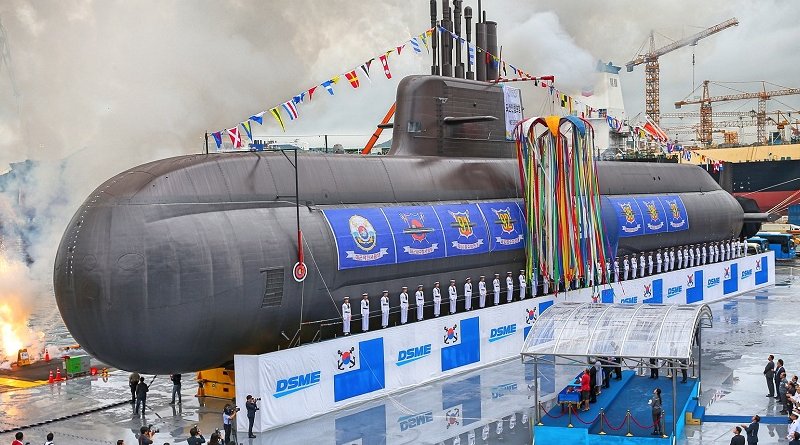Overlooked: South Korea’s Naval Shipbuilding – Analysis
By RSIS
South Korea’s sea trials of new indigenous submarine demonstrate that the country’s naval shipbuilding industry is entering a new phase of proficiency. This will mean a more capable blue-water South Korean navy, as well as promising to make Korea a major player in the global arms market.
By Richard A. Bitzinger*
South Korea (ROK) recently and very quietly achieved a milestone: in June it began sea trials of a new indigenous submarine, the Dosan Ahn Changho. This may not sound like much, but it is a noteworthy indicator of a stronger and more globally competitive Korean defence industry, at least when it comes to naval systems.
The Dosan Ahn Changho is the first in a new class of Korean submarine, designated the KSS-III. The KSS-I class was basically a licensed-produced version of the venerable Type-209, a submarine developed by Germany expressly for the export market. Since the early 1970s, 13 navies have acquired a total of 61 Type-209s, either built by Germany or produced under licence. South Korea constructed a total of nine KSS-I/Type-209s in the 1990s, also called the Changbogo-I class.
The Next Phase
The Changbogo-I was superseded in the 2000s by the KSS-II, or Changbogo-II, a licensed version of the German Type-214. The KSS-II/Type-214 was a major improvement over the Type-209: larger, heavier, and – more critically – outfitted with fuel cells for air-independent propulsion (AIP). AIP permits a conventionally powered (i.e., diesel-electric) submarine to remain submerged and silent for much longer periods, as long as three weeks. Korea launched nine of these boats between 2006 and 2017.
The third phase for Korean submarine-building is the KSS-III. At over 3,000 tons, it is one of the largest diesel-electric submarines around, making it big enough for long-range, blue-water operations. It features conventional torpedo tubes but is also outfitted with a six-silo vertical-system (VLS) for firing antiship and land-attack cruise missiles; later versions will feature ten VLS tubes and may even be armed with a ballistic missile. Like the KSS-II, it is equipped with a fuel-cell AIP system.
The first in this class – that is, the Dosan Ahn Changho – was launched last September and is slated to be ready for service by next year. This is seven years ahead of schedule, a reflection of just how important this programme is to the South Korean navy. Four KSS-IIIs have already been launched or are under construction, and a total of nine boats in this class is planned.
Why the KSS-III is Critical to South Korea
The KSS-III is a critical achievement for South Korea’s naval shipbuilding industry. In the first place, it is almost completely based on indigenously derived technologies. In just 25 years the Koreans have been able to effectively exploit foreign technologies through licensed-production and then successfully wean themselves off such a dependency.
This is a relatively short time when it comes to developing and manufacturing a highly advanced piece of weaponry like a modern submarine. Such, South Korea has joined a very exclusive club of countries capable of producing, on their own, such a sophisticated type of military equipment.
This capacity is being increasingly demonstrated in other areas of Korean warship construction. South Korea, as we all know, possesses some of the largest and most advanced commercial shipyards in the world. It is one of the largest producers of civilian ships – tankers, cargo vessels, container ships, and the like. Shipbuilding alone accounts for 6.5 percent of the country’s GDP.
This has worked to the advantage of the South Korean naval shipbuilding. As warship construction is embedded in much larger, commercially oriented shipyards, it has been able to take advantage of infrastructure (e.g., drydocks), production technology (e.g., CAD/CAM), and skilled labour that was developed for export-driven civilian ship production.
As a result, South Korea has built up a very sophisticated and increasingly proficient naval shipbuilding industry. Evolved products like the KDX-III destroyer and the KSS-III submarine demonstrate that the ROK is capable of designing and constructing state-of-the-art weapons platforms.
It is complementing these with the indigenous development and production of shipboard weapons systems (e.g., the Haesung and Hyunmoo-IIIC cruise missiles) and various homegrown defence electronics. South Korea will likely continue to aggressively push the envelope when it comes to developing next-generation warships.
Growing Export Potential of Korean Warships
The KSS-III is an indicator as well of South Korea’s potential to become a major player in the global arms market. In fact, South Korea has already begun to experience sustained success when it comes to arms exports. According to official MND statistics, South Korean overseas arms sales increased from US$253 million in 2006 to US$3.54 billion in 2015, and the number of countries acquiring South Korean armaments grew from 47 to 90 countries.
The South Korean naval shipbuilding sector has chalked up some export sales; it sold three Type-209 submarines for Indonesia, and two frigates to the Philippines, as well as a specialized LPD (landing platform dock) exported to Indonesia, the Philippines, and Peru.
Having products based on indigenous technologies have benefitted the naval export business. Indeed, one of the key impediments to South Korea exporting its T-50 fighter jet has been the restrictions placed by Washington on the re-export of ROK military equipment that contain US subsystems or components.
The KSS-III, as well as other naval systems (such as a new multirole frigate currently under development), underscores the increasing sophistication of the South Korean naval shipbuilding industry, as well as its growing capacity to prove that its products are competitive in the international arms market. When it comes to naval systems at least, South Korea may soon, right under our noses, show that it is a force to be reckoned with.
*Richard A. Bitzinger is a Visiting Senior Fellow with the Military Transformations Programme in the S. Rajaratnam School of International Studies (RSIS), Nanyang Technological University (NTU), Singapore. An earlier version of this Commentary appeared in Asia Times.

